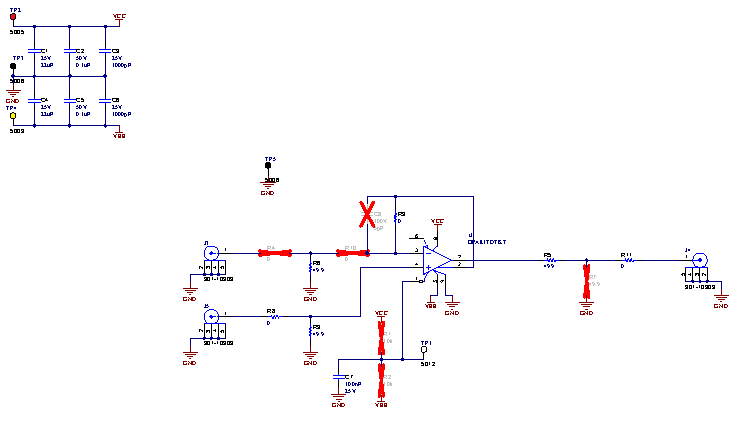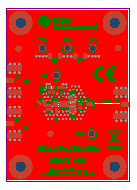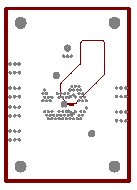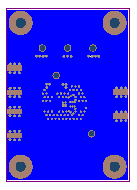DEM-OPA-DTK-EVM User's Guide
Abstract
The DEM-OPA-DTK-EVM is a demonstration fixture that helps designers evaluate the operation and performance of TI's high speed, wide bandwidth operational amplifiers. This unpopulated PC board is compatible with single channel amplifier products offered in the 8-pin SON (DTK and DRG) packages. The board is designed to accommodate multiple amplifier configurations to allow for maximum flexibility and ease of use.
Trademarks
All trademarks are the property of their respective owners.
1 Features
- Configurable for single or split-supply operation
- Includes optional termination resistors on inputs and outputs for easy use with 50-Ω test equipment
- Feedback network components for inverting and non-inverting configurations
- Standard SMA footprints for input and output signal connections
- High speed optimized layout to reduce parasitic effects
2 Power Connections
The DEM-OPA-DSN-EVM is equipped with test point connectors to easily power VCC, VEE, or GND. The positive supply input is labeled VCC, the negative supply input is labeled VEE, and the ground is labeled GND.
3 Operating Modes
3.1 Single-Supply Operation
To operate as single supply, connect both the VEE and GND connector to ground and apply the positive-supply voltage to VCC. In this configuration, a populated R7 resistor can present a static DC load to ground for the amplifier as it is not referenced to mid-supply in the single-supply configuration. Additionally, the input resistors R6 and R9 may pull the inputs of the amplifier to ground depending on the configuration. It is important to be aware of any device limitations in the mode of operation.
3.2 Split-Supply Configuration
To operate as split supply, apply the positive-supply voltage to VCC, negative-supply voltage to VEE, and the ground reference from supply to GND. In this mode the load resistor R7 and input resistors R6 and R9 are referenced to the mid-supply potential of ground.
4 Input and Output Configurations
The DEM-OPA-DTK-EVM is equipped with footprints for SMA connectors for connection of signal generators and analysis equipment. For best results, the input and output to the EVM should be terminated to 50-Ω impedances and signals must be routed to and from the EVM with cables having 50-Ω characteristic impedance. IN+ (J5) includes termination resistor R9 for non-inverting configurations. For inverting configurations an resistor network (R4, R6, and R10) is included to match the input impedance while maintaining a desired gain resistor value. VOUT (J4) is the output connectors for the amplifier. A resistor network (R5, R7, and R11) at the output of the amplifier can be used to convert the signal to 50-Ω single-ended source while providing a larger total load to the amplifier when terminated with 50-Ω load at J4.
Figure 6-1 shows the inputs and output configured in a typical unity-gain amplifier configuration with a single series output load resistor of 49.9-Ω to directly match 50-Ω test equipment.
5 Differences Between DTK and DRG Packages
The DEM-OPA-DTK-EVM board can be used with either of Texas Instruments 8-pin SON packages marked DTK or DRG. By default the board is design with the DTK package footprint, but it is also compatable with the DRG, which has a larger thermal pad than the DTK package. When using either package, the thermal pad solder amount should match the footprint on the board even if using the DRG package with the larger thermal pad footprint. In the case of the DRG package, the solder on the board will simply connect within the bounds of the larger thermal pad located on the device. It is important not to add extra solder to the thermal pad connection when using the DRG package as it could create short circuits under the package between the pins and the thermal pad.
6 Schematic
Figure 6-1 shows an example non-inverting unity-gain schematic configuration for the DEM-OPA-DTK-EVM.
 Figure 6-1 Schematic
Figure 6-1 Schematic7 Layout
Figure 7-1 through Figure 7-4 show the PCB layers of the DEM-OPA-DTK-EVM.
 Figure 7-1 Top Layers
Figure 7-1 Top Layers Figure 7-3 Power Layer
Figure 7-3 Power Layer Figure 7-2 Ground Layer
Figure 7-2 Ground Layer Figure 7-4 Bottom Layers
Figure 7-4 Bottom LayersIMPORTANT NOTICE AND DISCLAIMER
TI PROVIDES TECHNICAL AND RELIABILITY DATA (INCLUDING DATASHEETS), DESIGN RESOURCES (INCLUDING REFERENCE DESIGNS), APPLICATION OR OTHER DESIGN ADVICE, WEB TOOLS, SAFETY INFORMATION, AND OTHER RESOURCES “AS IS” AND WITH ALL FAULTS, AND DISCLAIMS ALL WARRANTIES, EXPRESS AND IMPLIED, INCLUDING WITHOUT LIMITATION ANY IMPLIED WARRANTIES OF MERCHANTABILITY, FITNESS FOR A PARTICULAR PURPOSE OR NON-INFRINGEMENT OF THIRD PARTY INTELLECTUAL PROPERTY RIGHTS.
These resources are intended for skilled developers designing with TI products. You are solely responsible for (1) selecting the appropriate TI products for your application, (2) designing, validating and testing your application, and (3) ensuring your application meets applicable standards, and any other safety, security, or other requirements. These resources are subject to change without notice. TI grants you permission to use these resources only for development of an application that uses the TI products described in the resource. Other reproduction and display of these resources is prohibited. No license is granted to any other TI intellectual property right or to any third party intellectual property right. TI disclaims responsibility for, and you will fully indemnify TI and its representatives against, any claims, damages, costs, losses, and liabilities arising out of your use of these resources.
TI’s products are provided subject to TI’s Terms of Sale (www.ti.com/legal/termsofsale.html) or other applicable terms available either on ti.com or provided in conjunction with such TI products. TI’s provision of these resources does not expand or otherwise alter TI’s applicable warranties or warranty disclaimers for TI products.
Mailing Address: Texas Instruments, Post Office Box 655303, Dallas, Texas 75265
Copyright © 2022, Texas Instruments Incorporated